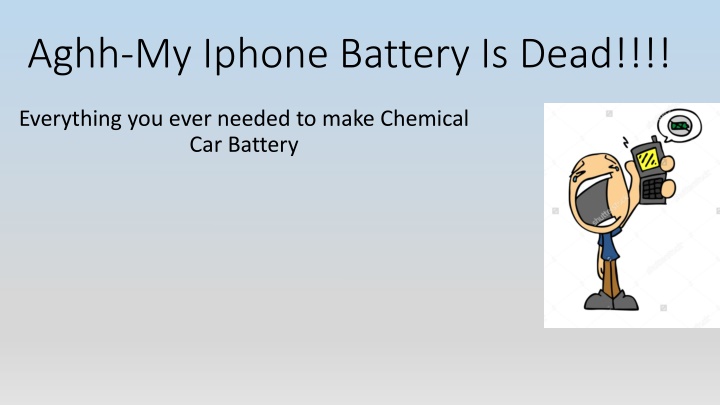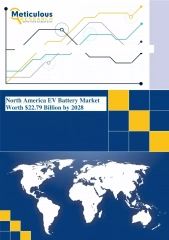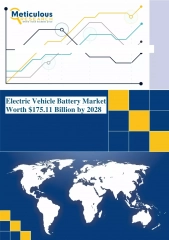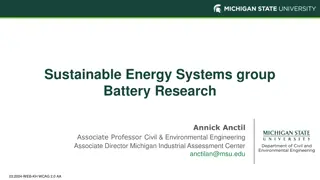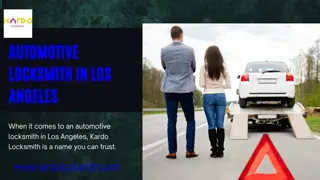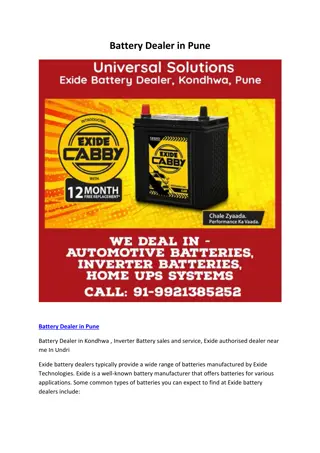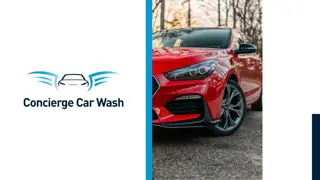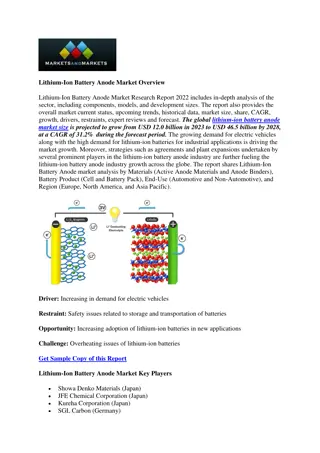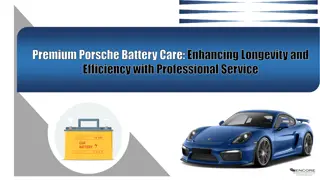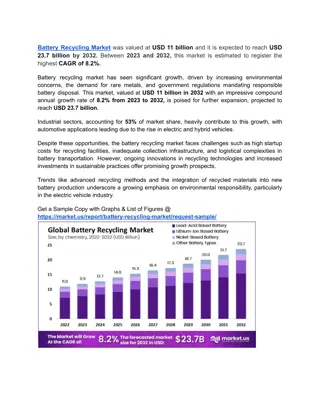A Beginner's Guide to Chemical Car Battery Making
Discover the fundamentals of chemical car battery production, including oxidation, reduction, voltage potential, and redox reactions. Learn how atoms interact, explore elements from the periodic table, and dive into terminology related to battery technology. Explore examples of favorable and unfavorable reactions, and uncover the secrets of creating a successful battery for vehicles.
Download Presentation

Please find below an Image/Link to download the presentation.
The content on the website is provided AS IS for your information and personal use only. It may not be sold, licensed, or shared on other websites without obtaining consent from the author.If you encounter any issues during the download, it is possible that the publisher has removed the file from their server.
You are allowed to download the files provided on this website for personal or commercial use, subject to the condition that they are used lawfully. All files are the property of their respective owners.
The content on the website is provided AS IS for your information and personal use only. It may not be sold, licensed, or shared on other websites without obtaining consent from the author.
E N D
Presentation Transcript
Aghh-My Iphone Battery Is Dead!!!! Everything you ever needed to make Chemical Car Battery
What Do We Already Know? Atoms and molecule can have positive or negative charge Periodic Table Trends: 1. Columns 1 and 2: Atoms try to lose electrons 2. Columns 6 and 7: Atoms try to gain electrons New Terms For This Week Oxidation Reduction RedOx Rxn Voltage Potential
What Do We Need To Know For Making A Battery Car? How do the chemical reactions work within a cell? How do cells relate to batteries? Best battery approach for the chemical cars? 2016 Corvette 650 HP: 0-60 mph: 3.3 sec mile time: 11.3 sec (max speed 128 mph) 2016 Tesla (Insane mode): 0-60 mph: 3.1 sec mile time: 11.6 sec (max speed 115 mph) KillaCycle: 0-60 mph: less than 1 sec mile time: 7.9 sec (max speed of 168 mph)
Terminology: Oxidation: e- are removed from a species Ca(s) Ca+2 (aq.) + 2e- E: 2.87V (High Voltage Potential) Sn(s) Sn+2 (aq.) + 2e- E: 0.13V (Low Voltage Potential) Reduction: e- are accepted by a species. F2 (aq) + 2e- 2 F- (aq) E: 2.87V (High Voltage Potential) AgBr(s) + e- Ag(s) + Br- (aq) E: 0.07V (Low Voltage Potential)
Terminology/Example Redox Rxn: Done in solution (typically H20) Combination of a reduction AND oxidation reactions Strongly Favorable Reaction Oxidation: Ca(s) Ca+2 (aq.) + 2e- Voltage Potential: 2.87V Reduction: F2 (aq) + 2e- 2 F- (aq) Voltage Potential: 2.87V Redox Rxn: F2 (aq) + Ca(s) 2 F- (aq) + Ca+2 (aq) V. Pot.: 5.74V
Favorable Reaction #1 Oxidation: 2 Li (s) 2 Li+ (aq) + 2 e- Reduction: Cu+2 (aq)+ 2 e- Cu(s) Voltage Potential: 3.0 V Voltage Potential: 0.3V Redox Rxn: 2 Li (s) + Cu+2 (aq) 2 Li+(aq) + Cu(s) Volt. Pot.: 3.3V Favorable Reaction #2 Oxidation: 2 K (s) 2 K+(aq) + 2 e- Voltage Potential: 2.9 V Reduction: Sn+2 (aq) + 2 e- Sn(s) Voltage Potential: -0.1V Redox Rxn: 2 K (s) + Sn+2 (aq) 2K+(aq) + Sn(s) Volt. Potential: 2.8V
Example Unfavorable Reaction Oxidation: 2 F- (aq) Reduction: 2 Na+ (aq) + 2 e- 2 Na(s) Voltage Potential: 2.71V F2(aq) + 2 e- Voltage Potential: -2.87V Redox Rxn: 2 F- (aq) + 2 Na+ (aq) F2(aq) + 2 Na(s) Volt. Pot.: -0.16V
Coca-Cola Battery Won t work with just deionized water? Only certain metals will work? Zn/Cu cell
Coca-Cola Battery Coke used because it contains an acid (H3PO4) Oxidation: Zn(s) Zn+2 (aq) + 2e- Voltage: 0.76V Reduction: Cu+2(aq) + 2e- Cu(s) Voltage: 0.34V Redox Rxn: Zn(s) + Cu+2 (aq) Zn+2(aq) + Cu(s) Voltage: 1.10V
Coca-Cola Battery-Zn Electrode The Zn electrode: Oxidation Zn(s) Zn+2 and 2 e- migrate to the Cu electrode. e- Zn+2 ions bond to PO4-2 -2 PO4 Copper Zinc Zn(s) reduces Cu+2 on the surface, coating the Zn electrode with Cu. H+ Zn+2 Cu+2 H+ -2 H+ PO4 -2 PO4
Coca-Cola Battery: Cu Electrode The Cu electrode Cu+2 ions reduced to Cu(s) e- Some Cu+2 ions make their way to the Zn -2 PO4 Copper Zinc Cu+2 Cu+2 Cu+2 is receiving e- (reduction) -2 PO4 H+ H+ -2 PO4
Coca-Cola Battery The Zn electrode Zn releases e- to the Cu electrode. Zn+2 ions bond to PO4-2 Zn(s) reduces Cu+2 on the surf., coating the Zn electrode with Cu. e- e- -2 PO4 Copper Zinc Cu+2 H+ The Cu electrode Cu+2 ions reduced to Cu(s) Zn+2 Cu+2 Cu+2 Zn+2 H+ Electrons do NOT move through the solution -2 H+ PO4 -2 PO4
Why Wont My Chemical Car Move? Voltage loss across any resistor: V= I x R Bad wiring on chemical car Very low current to your motor! Volts = Amps x Ohms Power loss to any resistor: W = V x I= V2 x I Watts = (Volts)2 x Amps Very low current to motor Very little power for the motor to use!
? Voltage loss across any resistor: V= I x R Volts = Amps x Ohms Power loss to any resistor: W = V x I= V2 x I Watts = (Volts)2 x Amps Car Battery/Wire Demo: V= 12V, Resistance of wire: 1 ohm 1. Amps through the wire: 12V = I (amps) x (1 Ohm) I=12 A 2. Power loss to the wire: W = (12V)2 x 12 A 1700 Watts Car Battery/Mr. Powers Demo: V =12V, Mr. Powers R: 1x106 ohms 1. Amps through Mr. P.: 12V = I (amps) x (1x106 Ohms) I=1.2X 10-5A 2. Power loss to Mr. Powers: W = 1.7 X 10-3Watts
Summary RedOx Reaction: Combination of 2 Processes Reduction: Chemical reaction in which a species accepts an e- Oxidation: Chemical reaction in what a species donates an e- Voltage Potential: Energy that would be exchanged in a e- transfer What s Next? Cells vs. Batteries Series vs. Parallel Cells Chemical cars will probably need to use parallel and series circuits
